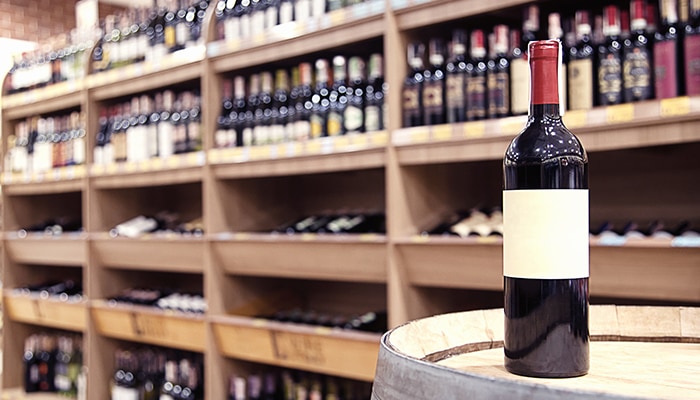VERTICAL FOCUS: Alcoholic Beverages

3 Tiers of the Wine Supply Chain
We can’t talk about wine without mentioning the Volstead Act, which made it illegal to “manufacture, sell, barter, transport, import, export, deliver, furnish, or possess” such beverages. Prohibition wasn’t just a temporary blip in alcohol manufacturing; it changed the way the supply chain functions.
Prior to Prohibition, the manufacture, sale, and transportation of beverages with an alcohol content greater than 1.28% looked different than it does today. Producers often owned their own retail outlets and served their local communities.
Today, alcohol—including wine—is highly regulated in the United States. After the repeal of Prohibition, the wine and spirits industry fractured into a three-tier system:
Tier 1: Producers. The first tier includes grape growers, wineries, manufacturers, suppliers, and importers.
Tier 2: Distributors. The second tier could be considered the middle man. These are the wholesalers. They purchase wine from the producers and then sell and deliver it to retailers.
Tier 3: Retailers. The third tier refers to not just stores but also restaurants.
–Thomasnet
6 Beer Trends Are Brewing
The beer brewing industry faces another year of uncertainty and evolving customer tastes. These six trends will guide the industry throughout 2023, according to SevenFifty Daily.
1. Consumers seek value in bulk beer and higher alcohol levels. As consumers try to get the most bang for their buck, they are buying beer in bulk or shopping for higher-alcohol-percentage products.
2. Breweries will trim SKUs and focus on specific styles. Increasing competition for shelf placements in grocery and liquor stores will lead breweries to eliminate slow-moving brands and rally around core beers. Focusing on fewer beers can help breweries better weather the vagaries of ingredient availability.
3. Breweries reclaim carbon dioxide in the face of supply chain disruptions. The carbon dioxide shortage caused a boost in innovation as brewers looked for ways to solve gas supply availability and reduce dependence on delivery. Breweries are also turning to a traditional technique called spunding, which traps carbon dioxide in tanks during fermentation, to naturally carbonate beers.
4. Global crises spur more local beers. The ongoing war between Ukraine and Russia—which together export more than one-quarter of the world’s wheat—and a terrible harvest for European hops will lead breweries to look closer to home for raw materials.
5. Beer merch and variety beer packs offer sales opportunities. The pandemic caused a spike in online shopping, and the digital shift will continue to lead breweries to emphasize online sales for merchandise and, where legally permitted, beer. Variety packs are also fostering aftermarket interactivity.
6. Taprooms become attractive interactive hubs. People now seek compelling places to gather that meet the needs of all ages. A bland taproom that offers only cold beer won’t cut it.
10 Largest Global Spirits Companies
(Based on current market capitalization)
1. LVMH Moët Hennessy Louis Vuitton. Paris, France
2. Kweichow Moutai. Maotai, China
3. Jiangsu Yanghe Brewery. Suqian, China
4. Anheuser-Busch. Leuven, Belgium
5. Diageo North America. London, England
6. Wuliangye Yibin Co. Ltd. Yibin, China
7. Altria. Richmond, Virginia
8. Pernod Ricard USA. Paris, France
9. Constellation Brands. Victor, New York
10. Brown-Forman. Louisville, Kentucky
SOURCE: Zippia
The Hard Stuff
The hard seltzer market continues to grow at an unprecedented pace and is expected to reach $76.9 billion by 2033. Additional key takeaways on the market from a Future Market Insights report:
- The hard seltzer market is particularly appealing to millennials and Gen Z consumers, who prioritize low-calorie and light beverages.
- The hard seltzer market is segmented based on alcohol content, with 5% to 6.9% ABV (alcohol by volume) hard seltzers generating the most revenue, accounting for 52% of market share in 2022. However, the sales of 1% to 4.9% ABV hard seltzers are projected to increase at a compound annual growth rate of around 24% between 2023 and 2032 due to the growing awareness of health concerns and the trend toward moderation, particularly in the United States.
- The bottle segment is expected to record a compound annual growth rate of 3.4% due to low processing costs and easy handling. Glass bottles are a popular option because they can be reused and recycled and they are durable.
- The off-trade distribution channel is the leading segment, generating 71%+ of global hard seltzer market sales in 2022. The segment’s growth was due to factors such as the well-established infrastructure of hypermarkets, supermarkets, convenience stores, and wine and spirit shops.
- The on-trade distribution channel segment is projected to expand at a rate of more than 23.5% from 2022 to 2030, fueled by bars, clubs, hotels, and lounges.
Sip on This
$1,609 billion: 2023 revenue in the alcoholic drinks market
Beer: The market’s largest segment at $610 billion in 2023
China: Country that generates the most revenue from alcoholic drinks
6.6% of total revenue: will be generated through online alcohol sales in 2023
42% of spending 25% of volume consumption: In the alcoholic drinks market will be attributable to out-of-home consumption–in bars and restaurants–by 2027
9.7 gallons: Average alcoholic drinks volume per person in 2023
– Statista
